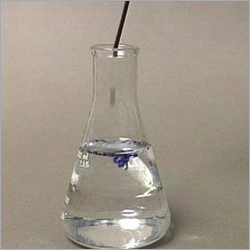
Liquid Polyelectrolyte
115.00 - 175.00 USD ($)/Ton
Product Details:
- Application Industrial
- Appearance Transparent liquid
- Usage Industrial
- Physical Form Liquid
- Poisonous YES
- Click to View more
X
Liquid Polyelectrolyte Price and Quantity
- 115.00 - 175.00 USD ($)/Ton
- 20 Ton
Liquid Polyelectrolyte Specifications
- Transparent liquid
- Industrial
- YES
- Industrial
- Liquid
Product Description
Liquid Polyelectrolyte is a water soluble polymeric compound that belongs to the class of cationic polymer which attracts negatively charged particles in the water such as suspended solids, colloids, and organic matter to ensure efficient cleaning of water. It is in high demand within various industrial applications which include paper & pulp, oil & gas drilling, mining, and textiles. It is available in sealed containers and should be stored in a cool, dry place away from sunlight. Customers can get this chemical compound in large volumes with an assurance of fast and safe delivery.
Liquid Polyelectrolyte Properties:
1. Electrostatic Interactions: Polyelectrolytes have charged functional groups (such as carboxylate, sulfate, or ammonium groups) along their chains. In a liquid state, these charged groups lead to strong electrostatic interactions with counterions (ions of opposite charge) present in the solvent. These interactions can affect the conformation and behavior of the polymer chains in solution.
2. Solution Viscosity: Polyelectrolyte solutions can exhibit high viscosity due to the entanglement of polymer chains and the repulsion between charged segments. The viscosity can be further influenced by factors such as polymer concentration, chain length, and ion concentration.
3. Swelling and Gel Formation: Polyelectrolyte solutions can undergo significant swelling when exposed to water or other solvents. This swelling behavior can lead to the formation of gels, where the polymer chains network and trap large amounts of solvent within the structure. These gels find applications in areas such as drug delivery, wound healing, and tissue engineering.
4. Response to pH and Ionic Strength: The properties of liquid polyelectrolytes can be highly sensitive to changes in pH and ionic strength. Altering these conditions can lead to changes in the degree of ionization of the polymer chains and the resulting electrostatic interactions. This sensitivity to environmental conditions is exploited in applications like controlled release systems and sensors.
5. Complex Coacervation: When two oppositely charged polyelectrolytes are mixed in a solution, they can undergo a phase separation process called complex coacervation. This leads to the formation of coacervate droplets rich in polymer chains, which can be used for encapsulation and separation purposes.
6. Rheological Properties: The mechanical behavior of liquid polyelectrolytes can be characterized using rheological techniques. Polyelectrolyte solutions can exhibit non-Newtonian behavior, such as shear-thinning or shear-thickening, depending on factors like polymer concentration and chain interactions.
7. Electrokinetic Phenomena: Liquid polyelectrolytes can exhibit interesting electrokinetic phenomena, such as electrophoresis and electroosmosis, where the movement of charged particles or fluid is influenced by an applied electric field. These phenomena are utilized in fields like microfluidics and separation techniques.
Applications of Liquid Polyelectrolyte:
1. Water Treatment:
- Coagulation and Flocculation: Liquid polyelectrolytes are often used in water and wastewater treatment to facilitate the removal of suspended particles and impurities. They help in aggregating and settling fine particles, improving the efficiency of processes like sedimentation and filtration.
2. Personal Care Products:
- Shampoos and Conditioners: Polyelectrolytes are used in hair care products to improve the texture and manageability of hair by providing conditioning effects through electrostatic interactions between the polymer and hair surfaces.
- Gels and Creams: Polyelectrolytes contribute to the viscosity and stability of gels and creams in cosmetic and skincare products.
3. Pharmaceuticals and Drug Delivery:
- Controlled Drug Release: Liquid polyelectrolytes are employed in drug delivery systems to control the release of active pharmaceutical ingredients over time, based on environmental factors such as pH or ionic strength.
- Micellar Drug Delivery: Polyelectrolytes can form micelles that encapsulate drugs, allowing for targeted and sustained drug delivery.
4. Biotechnology:
- Gene and Protein Delivery: Liquid polyelectrolytes are used to encapsulate and deliver genetic material or proteins into cells for various applications in gene therapy and biotechnology research.
- Tissue Engineering: Polyelectrolyte solutions can be utilized to create hydrogels that mimic the extracellular matrix, aiding in the development of artificial tissues and scaffolds for tissue engineering.
5. Food Industry:
- Food Additives: Polyelectrolytes are used as additives in food processing to modify the texture, stability, and appearance of food products, such as improving the viscosity of sauces or enhancing the shelf life of certain foods.
6. Electrokinetic Techniques:
- Microfluidics: Liquid polyelectrolytes play a role in microfluidic devices for manipulating fluids and particles at the microscale, enabling applications in lab-on-a-chip systems, chemical analysis, and diagnostics.
- Electroosmosis and Electrophoresis: Polyelectrolytes are used to modify the movement of particles and fluids in microchannels, enabling separation and sorting techniques.
7. Coatings and Adhesives:
- Surface Modification: Polyelectrolyte coatings can be applied to surfaces to modify their properties, such as enhancing adhesion, improving barrier properties, or providing controlled release capabilities.
8. Oil Recovery:
- Enhanced Oil Recovery: Polyelectrolytes are used in enhanced oil recovery processes to increase the viscosity of water injected into oil wells, facilitating the displacement of oil and improving oil production.
9. Textile Industry:
- Dye Fixation and Color Enhancement: Polyelectrolytes are used in textile dyeing processes to help fix dyes onto fibers and enhance color fastness.
10. Environmental Remediation:
- Soil Stabilization: Liquid polyelectrolytes can be applied to soil for stabilization, erosion control, and improvement of soil structure in construction and land reclamation projects.
FAQ:
1. What are liquid polyelectrolytes?
Ans: Liquid polyelectrolytes are solutions or dispersions of polymers containing charged functional groups along their chains. These charged groups interact with ions in the solvent, leading to unique properties and behaviors.
2. How do liquid polyelectrolytes interact with ions in a solution?
Ans: Liquid polyelectrolytes exhibit electrostatic interactions with counterions in the solvent due to the charged groups on their chains. These interactions influence properties like solution viscosity, swelling behavior, and phase separation.
3. What are some applications of liquid polyelectrolytes?
Ans: Liquid polyelectrolytes have diverse applications, including water treatment (coagulation, flocculation), personal care products (shampoos, gels), drug delivery, gene therapy, microfluidics, coatings, and more.
4. How do liquid polyelectrolytes affect water treatment processes?
Ans: Liquid polyelectrolytes aid in coagulation and flocculation, helping to remove suspended particles and impurities from water by aggregating and settling them.
5. Can liquid polyelectrolytes be used in drug delivery?
Ans: Yes, liquid polyelectrolytes are used to create drug delivery systems for controlled and targeted release of pharmaceuticals, based on environmental factors like pH and ionic strength.
6. What role do liquid polyelectrolytes play in microfluidics?
Ans: Liquid polyelectrolytes are essential in microfluidic devices for manipulating fluids and particles at the microscale, enabling applications in lab-on-a-chip systems, chemical analysis, and diagnostics.
7. How do liquid polyelectrolytes impact cosmetics and personal care products?
Ans: In personal care products like shampoos and creams, liquid polyelectrolytes contribute to texture, manageability, and stability, enhancing their performance.
8. Are liquid polyelectrolytes used in food processing?
Ans: Yes, liquid polyelectrolytes can be used as additives in food processing to modify texture, stability, and appearance of food products, improving characteristics such as viscosity.
9. Do liquid polyelectrolytes have any environmental applications?
Ans: Yes, they can be used for soil stabilization, erosion control, and environmental remediation, improving soil structure and stability.
10. How do liquid polyelectrolytes respond to changes in pH and ionic strength?
Ans: Liquid polyelectrolytes are sensitive to changes in pH and ionic strength, which can influence their degree of ionization and electrostatic interactions, affecting properties like viscosity and gel formation.
11. Can liquid polyelectrolytes be used in oil recovery processes?
Ans: Yes, liquid polyelectrolytes are employed in enhanced oil recovery by increasing the viscosity of injected water to improve oil displacement and production.
12. How are liquid polyelectrolytes used in gene therapy and tissue engineering?
Ans: Liquid polyelectrolytes are used to encapsulate genetic material and proteins for delivery into cells, aiding applications in gene therapy and creating hydrogels for tissue engineering.
13. Are there different types of liquid polyelectrolytes?
Ans: Yes, there are various types of liquid polyelectrolytes with different polymer structures and charged groups, allowing for tailoring properties to specific applications.
14. What is the significance of complex coacervation involving liquid polyelectrolytes?
Ans: Complex coacervation is a phase separation process where oppositely charged polyelectrolytes form coacervate droplets, used for encapsulation and separation purposes in applications such as controlled release.
15. How are the rheological properties of liquid polyelectrolytes characterized?
Ans: The rheological properties of liquid polyelectrolytes, such as viscosity and shear behavior, can be characterized using rheological techniques to understand
their flow and mechanical properties.
Enter Buying Requirement Details
Other Products in 'Industrial Chemical' category
 |
Chemtrade International Corporation
All Rights Reserved.(Terms of Use) Developed and Managed by Infocom Network Private Limited. |

 English
English Spanish
Spanish French
French German
German Italian
Italian Chinese (Simplified)
Chinese (Simplified) Japanese
Japanese Korean
Korean Arabic
Arabic Portuguese
Portuguese Call Me Free
Call Me Free Send SMS
Send SMS


